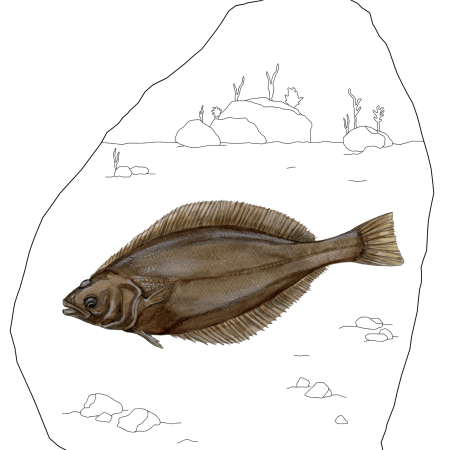
THE GREENLAND HALIBUT

- Greenland halibut stay in the Icefjord their entire lives
- The polar cod has adapted to extremely cold water
- The Greenland shark – the second largest predatory shark in the world
You solve the tasks by using
- Text
- Audio
- Drawing tools
- Pictures
This part is based on pp. 30-37 – there you will find information about the subject.
Read about the Greenland halibut, the polar cod and the Greenland shark.
The Greenland halibut is a right-eyed flatfish differing from other flatfish by having its left eye placed on the side of the body and not close to the right eye.

Greenland halibut live unlike many other flatfish both at the bottom and in the pelagic zone.
Greenland halibut in the Icefjord are on average fatter than halibut in the Disko Bay.
The Greenland halibut lives both at the bottom and in the pelagic zone. What does the pelagic zone mean?
The Greenland halibut is right-eyed – what flatfish are left-eyed?
Why are Greenland halibut in the Icefjord fatter than those elsewhere?
The polar cod can be distinguished for other cod by the fins.
The polar cod lives pelagic everywhere at the coast of Greenland.

It can grow up to 35 cm and become 6-7 years old.
The polar cod is not important to the fishing industry in Greenland but it serves as food for seals and whales.
What does it mean that the polar cod lives pelagic?
How has the polar cod adapted to life in extreme cold?
What would happen to the polar bear if the stock of polar cod were depleted?
The Greenland shark is a great mystery as it lives in very deep water and thus is difficult to watch.
Exactly how old it can grow is not known but it is considered to be the longest living vertebrate.

The Greenland shark is practically blind due to a parasitical copepod sitting in its eyes.
It moves very slowly and is called sleeper shark. Nevertheless it feeds on seal and cod.
Give an explanation of the niche of the Greenland shark – seen in relation to it being called the sleeper shark.
What is a vertebrate?
How has the Greenland shark adapted to life as almost blind in the deep sea without much light?
The Greenland halibut is a right-eyed flatfish differing from other flatfish by having its left eye placed on the side of the body and not close to the right eye.

Greenland halibut live unlike many other flatfish both at the bottom and in the pelagic zone.
Greenland halibut in the Icefjord are on average fatter than halibut in the Disko Bay.
The Greenland halibut lives both at the bottom and in the pelagic zone. What does the pelagic zone mean?
The Greenland halibut is right-eyed – what flatfish are left-eyed?
Why are Greenland halibut in the Icefjord fatter than those elsewhere?
The polar cod can be distinguished for other cod by the fins.
The polar cod lives pelagic everywhere at the coast of Greenland.

It can grow up to 35 cm and become 6-7 years old.
The polar cod is not important to the fishing industry in Greenland but it serves as food for seals and whales.
What does it mean that the polar cod lives pelagic?
How has the polar cod adapted to life in extreme cold?
What would happen to the polar bear if the stock of polar cod were depleted?
The Greenland shark is a great mystery as it lives in very deep water and thus is difficult to watch.
Exactly how old it can grow is not known but it is considered to be the longest living vertebrate.

The Greenland shark is practically blind due to a parasitical copepod sitting in its eyes.
It moves very slowly and is called sleeper shark. Nevertheless it feeds on seal and cod.
Give an explanation of the niche of the Greenland shark – seen in relation to it being called the sleeper shark.
What is a vertebrate?
How has the Greenland shark adapted to life as almost blind in the deep sea without much light?



